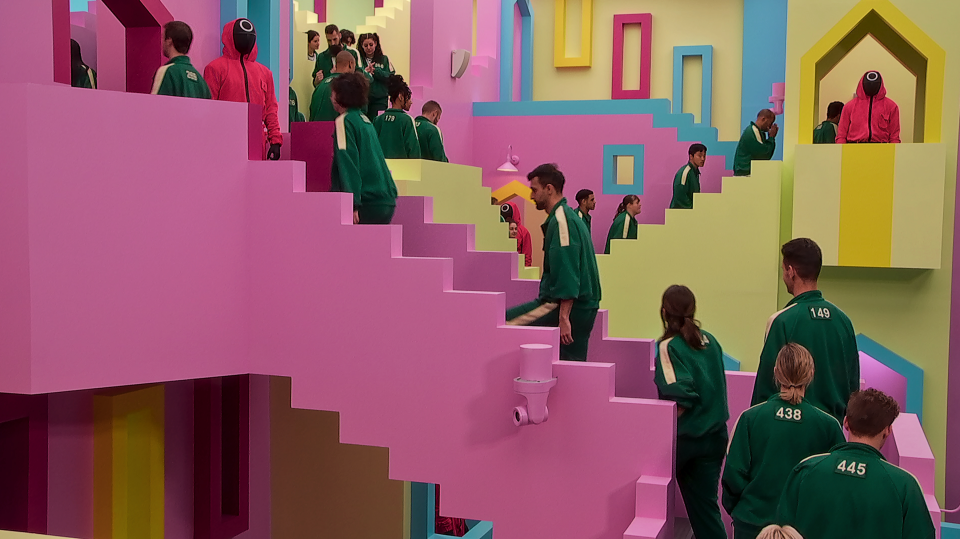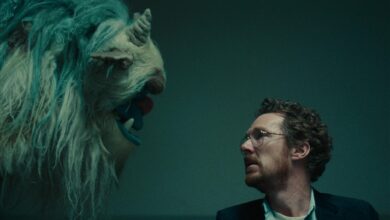Squid Games Maze Room: The Mysterious Staircase That Traps Players

Table of Contents
Introduction
Squid Games maze room is one of the most eye-catching and confusing places in the series. The colorful stairs, twisting hallways, and endless doors make it feel like a giant puzzle. But this beautiful space is not just for looks—it plays a big role in trapping and controlling the players.
The maze room in Squid Game is designed to confuse, disorient, and create fear. The pastel-colored staircases may look playful, but they lead to something terrifying. Inspired by real-life designs like Escher’s impossible staircases and Ricardo Bofill’s La Muralla Roja, this maze-like space symbolizes control, power, and the helplessness of those stuck inside.
The Squid Games Maze Room: A Beautiful Trap
The Squid Games maze room is one of the most striking places in the series. It looks colorful and fun, but it hides something dark. The winding staircases and endless doors make it feel like a never-ending puzzle. Players must walk through it, not knowing where it will lead them.
This maze is not just for decoration; it plays an important role in the game. It keeps the players under control, making sure they follow the rules. The bright colors may seem playful, but they only hide the fear and danger inside. Every step in the maze is designed to confuse and control the people trapped in it.
Why the Staircase in Squid Game Feels So Confusing
The maze room in Squid Game is designed to make people feel lost. The staircases go in many directions, and the hallways look the same. This makes it hard to know where you are or where to go next. The players are forced to walk through it without knowing what is waiting for them.
This confusing design creates tension and fear. The players have no choice but to follow the path, even if they are scared. The layout of the maze is similar to a prison, where the only way out is by following the game’s rules. This makes the players feel trapped and powerless.
The Meaning Behind the Maze Room’s Colors and Design
At first glance, the Squid Games maze room looks cheerful and bright. The colors used in the staircases are pink, blue, and green. These colors are usually found in children’s playgrounds, making the place feel friendly. But in reality, this colorful space hides a dark truth.
The design of the maze is made to confuse and control the players. The bright colors make them feel safe, but in reality, they are in danger. The contrast between the happy colors and the deadly game adds to the horror. This shows how the game tricks people into believing something that is not real.
Real-Life Inspirations Behind Squid Game’s Maze Room

The design of the maze room was inspired by real-life architecture. One of the biggest influences is La Muralla Roja, a famous building in Spain. This building has many staircases and bright colors, just like the maze room in the series. The creators of Squid Game used this idea to create a confusing and eye-catching space.
Another inspiration comes from the artwork of M.C. Escher, an artist known for his impossible staircases. His designs create an illusion where stairs seem to go in all directions. The maze room in Squid Game uses this idea to make players feel lost. These real-life inspirations make the maze room feel even more mysterious.
How the Maze Room Controls Players’ Minds and Actions
The Squid Games maze room is more than just a place to walk through. It plays with the minds of the players. The twisting hallways make them feel lost, and the closed doors make them feel trapped. The design is made to break their confidence and make them follow the game’s rules.
Everything in the maze is designed to control people. The staircases lead them in circles, making them feel hopeless. The guards in pink suits stand at every turn, making sure no one tries to escape. This kind of environment makes people feel small and powerless, forcing them to obey without question.
Escher’s Impossible Staircases: The Hidden Link to Squid Game
One of the biggest inspirations for the Squid Games maze room is the work of artist M.C. Escher. He created drawings of staircases that go in all directions, making it look like there is no way out. The maze in Squid Game uses this idea to confuse and scare the players.
Why Escher’s Artworks Matter:
- His staircases create an illusion of endless paths.
- They make people feel lost and unsure of their next step.
- Squid Game uses the same idea to control the players in the game.
By using Escher’s ideas, the creators of Squid Game made a place that is both beautiful and terrifying. It tricks the players into thinking they know where they are going, only to make them feel lost again.
How the Maze Room Creates Fear and Hopelessness
The Squid Games maze room is not just confusing; it also creates deep fear. The players have no idea where they are or where they are going. Every corner looks the same, making them feel like they are stuck forever. This feeling of being trapped makes them more desperate to win the game.
Ways the Maze Room Creates Fear:
- The endless staircases make players feel like they are going nowhere.
- The guards watching at every turn add to the pressure.
- The bright colors create a false sense of safety, making the reality even more shocking.
This room is designed to break the spirit of the players. It shows them that they are under full control of the game masters, with no way to escape.
The Connection Between the Maze Room and the Real World
The Squid Games maze room is more than just a part of the game. It is a symbol of the struggles people face in real life. Many people feel trapped in their daily lives, just like the players in the maze. The endless staircases represent the cycle of work, debt, and survival.
The design of the maze room teaches an important lesson. It shows how systems of power control people, keeping them in place. Just like in real life, the players in the game must follow the rules to survive. The maze room is not just a set; it is a reflection of society.
Lessons We Can Learn from the Squid Games Maze Room

The Squid Games maze room is not just a place for the players to walk through. It teaches us valuable lessons about control, fear, and survival. By looking deeper into its design, we can see important messages hidden within the game.
What We Can Learn:
- Systems of power control people by keeping them confused and scared.
- Bright and happy appearances can sometimes hide something dark.
- It is important to understand the tricks used to keep people under control.
The maze room is one of the most powerful parts of Squid Game. It is not just about its colors or staircases; it is about what it represents. It reminds us to look beyond what we see and understand the real meaning behind things.
Conclusion
The Squid Games maze room is more than just a set in the show. It is a powerful symbol of control, fear, and illusion. The bright colors trick the players into feeling safe, but the endless staircases show that they are trapped. This design makes the game even more intense and terrifying.
This maze teaches us an important lesson about life. Sometimes, things that look fun and harmless can have a hidden danger. It also reminds us that feeling lost and powerless is something many people face in real life. The maze room is not just part of the game—it is a mirror of our own world.
FAQs
Q: What is the Squid Games maze room?
A: It is a colorful, twisting staircase that players must walk through in the Squid Game series. It is designed to confuse and control them.
Q: What inspired the design of the maze room?
A: The design was inspired by La Muralla Roja in Spain and the impossible staircases drawn by M.C. Escher.
Q: Why is the maze room so confusing?
A: The staircases and hallways look similar, making it hard for players to know where they are going. This creates fear and control.
Q: What do the bright colors in the maze room mean?
A: The colors make the place look fun, but they hide the true danger of the game.
Q: What lesson can we learn from the maze room?
A: It teaches us that things are not always as they seem and that systems of power can trap people in ways they don’t realize.




